Unlike many cities, Hull does not have a public memorial which lists all the names of the fallen in the First World War.
Hull has a Cenotaph at Paragon Square, but this does not list any individual names.
The ‘Golden Book’ of Remembrance commissioned after the war and kept at the Holy Trinity Church, in Hull’s Market Place, is probably the most complete, hand written record of servicemen that died in the First World War. Through public Notices published in newspapers, libraries and churches, Hull citizens were encouraged to submit the details of fallen servicemen on a standard form so that their names could be recorded in the ‘Golden Book’. As not everyone read newspapers or could read or write, and in a world before television and social media, it is not surprising that this message failed to reach everyone. For this and many other reasons, not everyone submitted details before the deadline and the ‘Golden Book’, does not record all the Hull men, that died in the First World War.


There are inevitably some errors and omissions on War memorials that provide a long list of names. This is because War memorials were compiled by different individuals and organizations, at different times and in different ways. This led to inconsistencies and revisions as records were amended over time. The many memorials can therefore include some duplications, anomalies, and misspellings. For example, Private Reed, known as Albert Reed in Hull’s Holy Trinity Register is recorded as Alfred Reed by the Commonwealth War Commission. Similarly, the Register records Ernest Donkin, whose first name was actually Edward. Private, Joseph William Templeton in the CWGC records, appears as “Temperton” in the Regimental Soldiers Died records.
Often the local church would initiate a Church memorial by visiting parishioners, door to door, to collect subscriptions and names of the fallen. This was not the most reliable way to collect accurate or comprehensive information. It was possible some families had moved from the area, or relatives were away, or could not afford a financial contribution to have a name remembered. Some requested the names of fallen relatives from outside the area to be included in local memorials. Others, included those wounded, or men that had served and survived the war, or those that died after the war, due to wounds or disease. For single men lost, with no next of kin, it relied on others to remember them. If they had no family their names may be missing from a memorial. The Sculcoates Parish War Memorial at St Mary’s Church, records 175 names of the fallen, but the ww1hull.com website, reveals that at least 218 men died from this area. The Clifton Street School Roll of Honour, lists George Dukes, RFA, and William Ransom, MGC, as died, but there are no regimental or Commonwealth War Records of their deaths. The literacy skills of those compiling casualty lists also varied and led to many errors. Poor handwriting and reading skills meant names were mis-spelt or mis interpreted. These mistakes were then passed to the carpenters and stone masons who transferred the errors, in good faith, on to the memorials. The names carved on the stone pillars of St Mary Church on Sculcoates Lane, provides an example of these difficulties. For example, Arthur Hanstock’s surname, is spelt “Handstock”, on the memorial and “Hunstock” in the Hull Daily Mail. The name Amos Spruit appears, but there are no Commonwealth War Grave records to suggest he died. Unusual names, like S. Cooter appears on the same memorial and is untraceable. This suggests a spelling error. The St John Newland Church records Arthur, William and John Lea as fallen. However there are no military records to associate these casualties with Hull. Could the Surname “Lea” be Lee or Leaf etc, or where these men who served or died after the war?
Popular names like John Smith, or local family surnames, such as Taylor, Harrison, and Chapman are numerous and usually difficult to trace with certainty. There are for instance 142 ‘Smiths’ listed on the ww1hull.com website memorial.
Sometimes surnames, like Clarke, may be spelt without an ‘e’ on the end, or visa versa. Initials may mean a variety of names. The Name Fred can refer to Alfred, Wilfred, as well as Frederick. Similarly Bertie may mean Bertram, Wilbert, Herbert or Albert, or may not necessarily be the first name, but a nickname. The name “Jack” for example may be a short hand for John Henry, or “Harry” may mean Henry as well as Harold. To compound matters further, some servicemen enlisted under different names or not under their true family name. Others went by different names or ‘nicknames’, for example, Francis Smith Hewitt who died on the Somme, was confusingly known as ‘Jack’? Private, Charles Brown, from Epworth Street, killed in 1917, was actually Clarence Reginald Brown? Those that enlisted often lied about their age or enlisted under different names, which adds to the confusion. For many such reasons memorials are not always accurate or comprehensive records of those that died.
 Missing Records
Missing Records
Searching soldier’s records to positively identify a serviceman, their unit and where they lived is also difficult. Over 60% of the National Archives were destroyed in the 1940 London Blitz. This included the War Records of five million British men and women that served in the World War One.
There is another set of records called the ‘Un-Burnt Series’ which includes 750,000 records of soldiers who were discharged for medical reasons during the war. They also include some pre-war soldiers whose term of service ended before 1920. However there are large gaps in both sets of records and it is necessary to unscramble many errors within them.
Pension Records
In November 2012, the Western Front Association acquired some 6.5 million Pension Record Index Cards and Ledgers. These help cross check information and can potentially provide unique information, such as an individuals unit, next of kin, wounds and injuries received (or disabling ailments), recovery from wounds and injuries in the post war years and pension entitlement. The Pension Record Index Cards are an invaluable source of information. They are divided into five unequal sections.
1. ‘Other Ranks Died’ (nearly one million individual cards);
2. ‘Widows and Dependents of Other Ranks’ (in excess of one million cards);
3. ‘Other ranks Survived’ (approximately 2.5 million cards)
4. ‘Officers Died and Widows of Officers’ (approximately 150,000 cards.
5. ‘Mercantile Marine’ (less than 5,000 cards)
The Ledgers are a series of numerically sequenced books, and are divided unequally into the following seven categories:- Disabled Soldiers; Disabled Naval ratings; Disabled Airmen; Widows; Dependents; Alternative Pension cases, and Alternation Widows Pensions. However, there are still anomalies and errors within these records. There is also a fee to access them, which is to be paid in advance which can exclude researchers.
Other Records
While many First World War records are incomplete or lost, there are regimental histories, and organizations, such as the Commonwealth War Grave Commission, the Public Records Office and the Imperial War Museum which can help trace those that died. There is a growing number of Genealogy sites which access records on line, although you invariably have to pay for these services.
Electoral records can link these men to particular streets and areas. The Absent Voters Registers 1918-19, can help identify a serviceman’s address at the end of the war. (These are kept in the Hull History Center). Although these only include servicemen aged over 21 who were eligible to vote. Trade Directories can reveal servicemen’s occupations before the war. Census records can highlight their family details and where they lived, plus information on what they did and where and when they were born. The most relevant of these is the 1911 Census, but as this is three years before the war started, it is possible men may have changed address by then. Local newspapers, museums, war dairies and journals can provide stories and photographs of the fallen, or at least indicate what life was like for many of them. The Hull Daily Mail often reprinted the names of the fallen on the anniversary of their deaths. This can be a good source to confirm and cross check family details. Once you have discovered your soldier ancestor you can learn more about them from other records – see the ‘blog’ below.
The Kingston Upon Hull Memorial, has looked at all these sources to provide you the most accurate information possible on each Hull casualty. The website also receives regular feedback from relatives and promptly updates contributions to ensure that this is a reliable, accurate and comprehensive data base. The reader can search by name, regiment, or date of death. More interestingly by plotting the addresses of the fallen, it is possible to visually show the impact of casualties on local communities over time. Unlike books, or lists of names on war memorials, mistakes on the database can be easily corrected and anomalies clarified and discussed. The website is also easily accessible on line, and free of charge to use. Over time it is hoped to add photographs of the fallen and a picture gallery of all war memorials in Hull. This will help those unable to access Churches or other buildings, to see the many and varied ways casualties were remembered in Hull. All contributions, amendments and photographs to the site are welcomed and acknowledged. You can also leave your contact details on the website, if you wish to be contacted directly regarding your relatives. This Memorial Site is for You, for Kingston Upon Hull, and for all for those interested in the First World War.